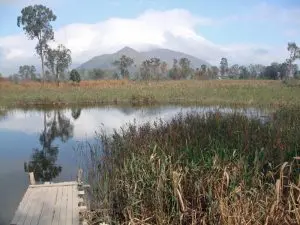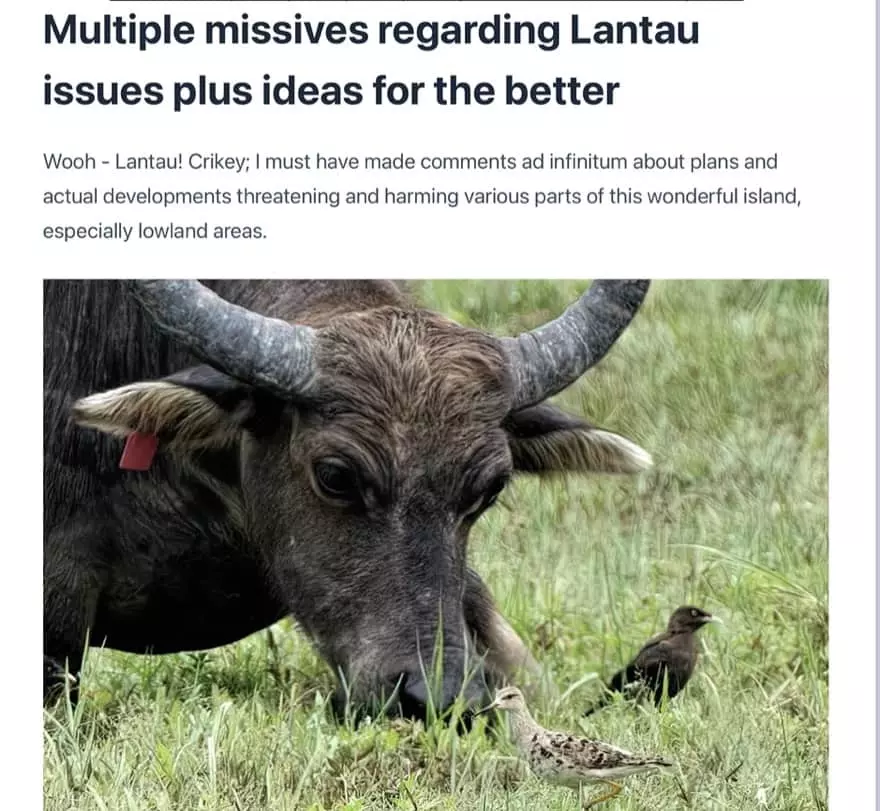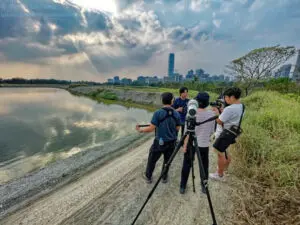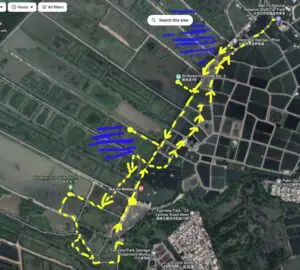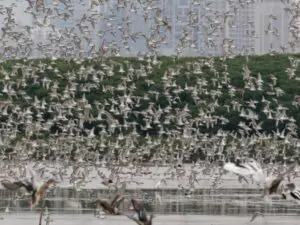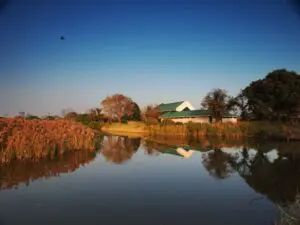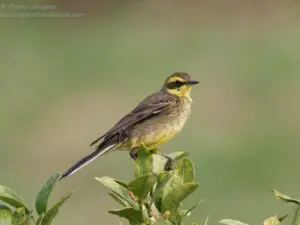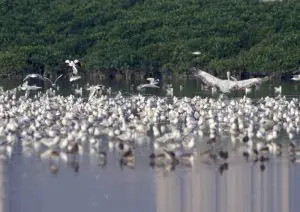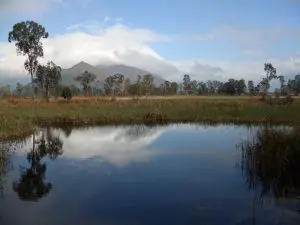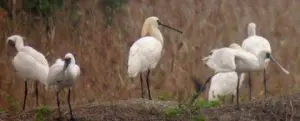
There is a Mai Po upgrade project underway [spring 2023], funded by a HK$347.86 million grant from the Hong Kong Jockey Club Charities Trust. This seems a substantial sum, especially as it is for infrastructure only, and chiefly a new visitor centre, the Peter Scott Field Studies Centre – for very few visitors….
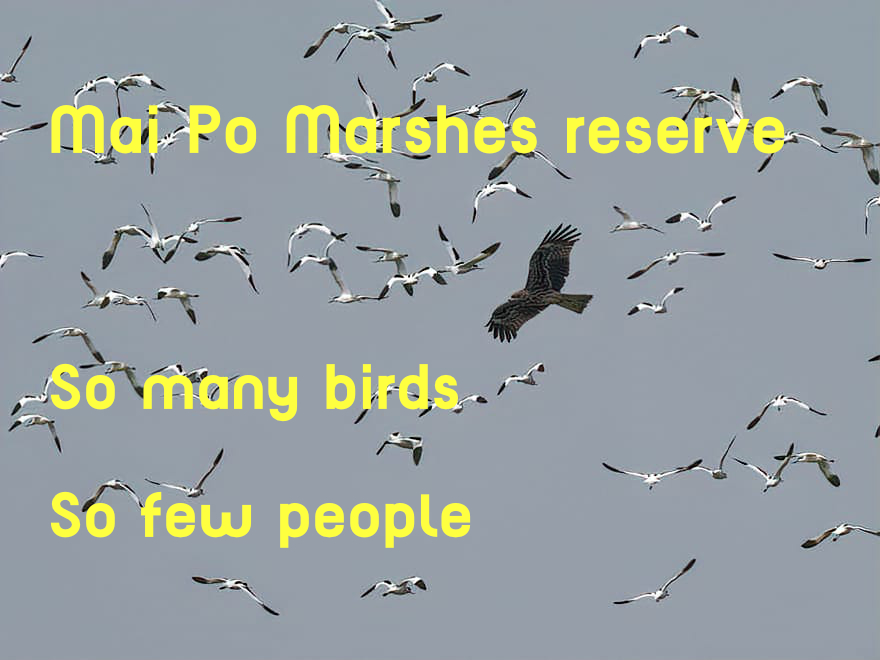
The local Mai Po community is described by WWF HK as, “Students, teachers, public visitors, families and community groups as well as dedicated researchers and birdwatchers.” On the face of it, this seems a good mix. Yet only around 32,000 visitors per year, in a place with a population of over 7 million and Mai Po the only world-class wetland reserve.
The upgrade project has come in for criticism, as in this article: Conservationists criticise wildlife NGO WWF over redevelopment project at Hong Kong nature reserve.
Rather than just point out issues, I’ve suggested a few ideas for changes that may be for the better, in a related webpage: Masterplan for a More Sustainable Future for Mai Po, Deep Bay Wetland and Beyond.
Below, info including some comparisons with wetland reserves elsewhere in the world; compared to them, Mai Po is an outlier for being highly restrictive re visitors.
London Wetland Centre: smaller, way more visitors
Quick look online regarding the somewhat comparable London Wetland Centre, and I find the cost for the centre, developed in the late 1990s, was around £16 million: this included “the development of the whole [44-hectare] site, including the Conservation Training Centre”: London Wetland Centre (by a developer of exhibits).
I also find that, in a city with a population of around 9 million, the London Wetland Centre attracts around 225,000 people per year; yet also supports significant numbers of waterfowl, especially wintering ducks [see below for 2021 figure, impacted by Covid].
That’s over 7x the number of Mai Po visitors, in a newer reserve that’s less than half the area.
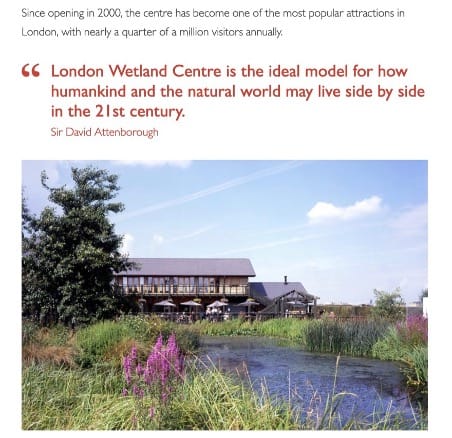
And yes, Hong Kong has a Wetland Park, intended to be a place for many visitors while Mai Po remained quiet. But it has a huge centre, only tiny habitats, poor reserve visiting experience.
Wetland reserve entry fees: Mai Po on high side
While the HK$3350 that Mai Po sought from my client for my entry to Mai Po was surely a one-off, rather freak occurrence, the regular entry of HK$250 charged to visitors to Hong Kong is somewhat on the high side.
I have done a little checking online, and found:
Aransas – big wetland reserve I’ve been to in southeast US: US$5 – two or more adults in a vehicle; that’s around HK$20 each then
Minsmere, UK; an early a model for Mai Po. If you are not a member of RSPB, then the entry fees are £8 for adults, £4 for children or £5.50 for students. Under 5s are free, and one child is free with two paying adults. – so that’s around HK$80 for adults.
Tamsui River Mangrove Nature Reserve, Taiwan – not seeing about fee; maybe free entry
Sungei Buloh Wetland Reserve, Singapore – $3, so around HK$18
Tidbinbilla, Canada – C$14.5 per car, so maximum around HK$85
WWT reserves in UK, £16 – so around HK$150
HK Wetland Park [poor habitats, as noted] HK$27/30.
Some UK wetland reserve visitor numbers
A document on Developing a Wetland Centre notes that “Peter Scott, founder of the Wildfowl & Wetlands Trust, considered that wetland centres (and indeed WWT generally) are important to ‘bring people and wildlife together for the benefit of both’.”
The WWT indeed seeks to attract both people and wildlife.
For instance, on the Association of Leading Visitor Attractions website, there’s a page with visitor numbers for 2021, including three WWT reserves with over 100,000 people during the year:
| WWT Slimbridge | 185,726 |
| WWT Martin Mere | 122,552 |
| WWT London | 104,836 [Impacted by Covid closure; surely other reserves too] |
Minsmere, the RSPB’s flagship reserve, attracts around 80,000 visitors per year, “who spend an estimated £8 million locally, supporting 66 local jobs”: RSPB reserves and local economies.
Visitors can bring revenue
As noted above, visitors can bring important revenue; and as I learned from recent exchange with Mai Po staff (had sought HK$3600 for entry for me as guide and one client; effectively HK$250 for him, and a whopping HK$3350 for me), Mai Po Marshes really needs monies for maintenance.
Yet more visitors can bring more revenue. And not just from entry fees. I was well used to the shops, cafes at UK wetland reserves; a Tripadvisor reviewer noted for London Wetland Centre:
“Good range of souvenirs and gifts in the shop.
Nice choice of food and desserts in the café.”
[The Hong Kong Jockey Club is of course familiar with such notions; F&B etc surely important at race venues.]
Visitors can boost support for conservation
While it’s nice to bring children to Mai Po, in school groups, I believe most may never visit Mai Po again.
Instead, surely better to have visitors who can become familiar with, emotionally attached to, Mai Po – and in turn support conservation here and elsewhere in Hong Kong.
Note, for instance, the massive public outcry over attempted development at Sai Wan, Tai Long Wan – largely as so many people had hiked there, and felt affinity with the area. This is included in a Green Victories article by WWF Hong Kong; yet WWF HK was surely not the key player in countering the development; “‘Friends of Tai Long Sai Wan’, a Facebook group set up last Friday, attracted over 46,000 members in four days“.
Threats to areas in the Deep Bay wetland continue; and public support is surely vital for the wetland’s long term future. More visitors can surely mean more support.
Threats to Hong Kong’s wetlands – in Deep Bay and elsewhere
Surely a major beneficiary of having few visitors to Mai Po is the miscellaneous group of wannabe and actual destroyers of wetlands across Hong Kong – for with fewer wetland fans, there is less opposition to their efforts.
And if wetlands are seen as places for wildlife, not people, that will greatly diminish the appeal of any ideas for nature tourism type projects: so if you own wetland, it will appear the only way to profit from it is through concreting. Yes, that’s the tried and tested approach worldwide, and only way to make lots of money, especially fast; but if Mai Po had thriving wildlife and visitors, could help show there is another way.
As to those threats, I’ve done articles here on development plans such as for Sunnyville, and ongoing ideas for Nam Sang Wai, and Fung Lok Wai fishpond areas; see also this on wannabe developers buying wetland land plots, even through entities registered in the Seychelles (coz, you know, can take such public pride in wanting to destroy wetlands): The wetland grab: investors rush to buy remote land near technology park project. Elsewhere, various lowland wetlands such as Pui O and Sham Chung suffer from often piecemeal development, too frequently appearing like petty vandalism.
Mai Po as leader of Deep Bay area conservation
Plus, Mai Po could guide, nurture and encourage “nature tourism” in fishponds and other areas around the reserve: Mai Po could be better integrated. Potentially, could combine visits to Mai Po with other areas – spread the “load”, so there are still quiet core areas within Mai Po and elsewhere in Deep Bay even as boost the numbers of friends/fans of Deep Bay.
Jockey Club unimpressed by the above
Without any real hope of stimulating change, I sent the above to Dr Gabriel Leung, Executive Director, Charities and Community, Hong Kong Jockey Club – along with covering letter as follows:
I am writing regarding the HK$347.86 million the Jockey Club is donating for the Mai Po upgrade project, and visitors to Mai Po – or rather, the relative lack of visitors.
I began birding in the UK, so became very used to reserves with many visitors, such as Minsmere (something of an early model for Mai Po). See enclosed notes for more info on other places.
I’ve been here in Hong Kong since 1987, and always believed there are too few visitors to Mai Po: partly as more visitors can bring revenue, also boost support for conservation of Mai Po, other wetlands.
Now, with this upgrade project, it might seem visitors would be more welcome.
But no!
Over the years, I have guided visitors to Mai Po, most recently [pre-Covid] finding it simple to “rent” a permit, so let my individual permit lapse.
But a few days ago, after being asked to guide a birder, I encountered serious issues. For him, ok to pay HK$250. But he would have to pay an additional HK$3350 for me to accompany him: world record for a simple reserve entry?
– in the event, when we arrived at Mai Po, the fee was waived; it surely helped my client is an ambassador for the RSPB in the UK, and had even contacted the CEO who emailed Mai Po asking them to help with his visit.
At the same time, a Canadian couple planning a very short visit to Hong Kong were refused a permit; even though clearly keen birdwatchers. This seems like Mai Po saying no to an easy HK$500.
Yes, there are issues with visitors, and free for all entry not good either.
But seems to me the situation with visitors at Mai Po is highly unbalanced; and those fancy new facilities will be empty or almost empty much of the time.
– during visit with my client a few days ago, we encountered maybe three birders/bird photographers and a school group; other people seemed to be staff; very nice to have reserve almost to ourselves, but not sure it’s a good thing overall.
Back around 1988, Dr Ken Searle – an influential figure in the early days of WWF HK and Mai Po – told me of ideas for a short trail for people to follow on self-guided visits; not accessing other areas, limited to serious birders, guided groups.
Seems a simple idea; may suit many Hong Kong people who haven’t experienced such a place – and suit the HKJC’s aims: “the Trust is committed to improving the quality of life of the people of Hong Kong”.
To me, it’s deeply sad the monies are not being used for such facilities; grand visitor centre hardly needed if few visitors! [with Mai Po staff not wanting people to simply pay for ticket to walk such a route].
Letter from me to Dr Leung
Had this reply by email:
Thank you very much for your query dated 3 March 2023. Dr Leung asks me to reply on his behalf.
The Jockey Club Charities Trust (the “Trust”) donated $347.86 million to the World Wide Fund for Nature Hong Kong (“WWF-HK”) in 2015 to upgrade its facilities at the Mai Po Nature Reserve. Challenges by the COVID-19 pandemic under which supply chains were disrupted and public health measures suppressed the visitation, the new Peter Scott Field Studies Centre was substantially completed in early 2023, pending necessary statutory approval. WWF-HK advises that the number of visitor has increased from 78 in February 2022 (when Hong Kong was facing the fifth wave of outbreaks) to 2,202 in February 2023.
Although the Trust does not fund any guided tours to the Mai Po Nature Reserve, we are given to understand that WWF-HK has sought funding from the government and other parties to offer free guided visits or subsidised programmes for students and teachers, youths and under-privileged communities. Members of the public may register for guided visits with a fee to visit the Mai Po Nature Reserve.
We hope to see you on the new Peter Scott Field Studies Centre soon.
Sean Leung, Deputy Executive Manager, Charities, The Hong Kong Jockey Club
Very corporate-ese! And yes, at least there was a reply; I thought my letter would be ignored, instead a reply that merely ignores the info I’d provided….
Thanks for the email; which replies to but does not answer my query, or respond to the information I provided.
Perhaps you didn’t read the letter and info; easier that way of course.
Such as London Wetland Centre, after Covid impact – 104,836 visitors in 2021.
You are “given to understand” re Mai Po?- is that the best you can do?I cite HK$3600 invoice, for one person plus me. Had the following comment to a Facebook post I did; the reserve even tries charging one person HK$3600 for single visit; and presumably pretending in invoice it’s a tour for six.
Will you really see me at the new Peter Scott Field Studies Centre? How much time will you be there; will you visit Mai Po to see for yourselves, or just be given to understand via second-hand info.- maybe, let’s arrange a visit, can talk in person. That could be interesting.
After all your huge funding, Mai Po might be the world’s least visited major wetland reserve, with highest charges. Evidence otherwise? [Deflection about freebies and subsidised tours, for some, should not really detract from significance of this; I noted charges at various other reserves.]
Well, I guess you folks can afford such largesse, thanks to HK people, and not really too concerned about actual results; but let’s see…[if really concerned, Dr Leung might have replied himself]
Also, not surprisingly, nothing from you regarding why shrimp ponds/fishponds – key to Mai Po’s importance – can’t be considered as infrastructure, so funds can be used for improvements.Just corporate blandness from you; really not up to the situation, not showing any real concern/appreciation for nature conservation that I notice.… as a sort of PS, as with letters in days of yore, this FB comment to my post:
//Completely agree with your post here. I’ve visited Mai Po a few times over the years. Sad to say the visits have become gradually worse over time.
I called the WWF a few weeks ago to give them a big hint that their 3600 entry was ludicrous for one person and guide. Who would pay that? You can fly to Taiwan and view wetland birds for free at that same price.
When it comes to increasing regular visitors, their tourist visit price is 400, which is a similar entry price as Ocean Park. Unfortunately, at the moment I’d say even a visit to OP is far more stimulating and educational.
On a tour you get stuck with people who run up the banks and “woo” at a bird flying. Most birds can and will fly away, especially if you trundle noisily through their habitat. That is a perfect opportunity to educate people on how to approach wildlife correctly. “Quietly observe, don’t disturb.” This wasn’t done on the tour. Plenty of selfies taken.
WWF need to take into consideration visitors who want to visit the site not as tourists but those genuinely interested in doing some bird spotting. Perhaps a 4-5 hour trip, just one or two people and a guide, mainly sitting in the bird hides – $600?. These are the folks who will visit more frequently. Providing the entrance fee isn’t burning a hole in their pockets. Nobody is going to want to pay 3600 for an individual visit, without feeling the pinch as you did DocMartin Williams.//
From me, to Jockey Club
Suppose you were ageing and with various ailments, yet still attractive to many; and you were in the care of someone who is doing nothing…
After I posted in a birding whatsapp group about issues with the Long Valley Nature Park, I was surprised at a response, sent to the…
If you’re among the privileged few with access to the inner sanctum of Deep Bay in northwest Hong Kong – a viewing hide at the…
If you’re unfamiliar with the Deep Bay wetland shared by Hong Kong and Shenzhen, you might wonder about the significance of the expanse of fish…
Here’s a film I made about Mai Po, using footage James Reynolds and I shot for the reserve, in English, Cantonese and Mandarin versions: Mai…
Yes, this is may seem impossible, ridiculous; but continuing with current state of affairs doesn’t look good for long term future of Deep Bay wetlands.…
Last decade, the future looked bright for the Deep Bay wetland, in northwest Hong Kong. [I wrote this for the South China Morning Post in late…
The WWF Hong Kong managed Mai Po Marshes Nature Reserve has undergone an infrastructure upgrade, with a HK$347 million grant from the Hong Kong Jockey…
With the apartment blocks of Yuen Long and Tin Shui Wai to the southwest, Fairview Park estate to the south, and the urban sprawl of…
A “battle of the ponds” is underway in Hong Kong’s northwest corner. It focuses on Deep Bay, a wetlands area that borders on China, near…
“If you look at satellite photos of the Pearl River delta, Deep Bay really shows up. There is nothing else like it.” David Melville Published…
Though Mai Po Marshes is at the heart of Hong Kong’s internationally important Deep Bay wetland, there are other important sites in the area –…
Mai Po is a key component of the internationally important Deep Bay wetland, which straddles the border between northwest Hong Kong and Shenzhen.
Deep Bay in northwest Hong Kong is a wetland of international importance, a magnet for migratory waterbirds.
Mai Po Marshes has become one of the world’s greatest wetland reserves – and a place I’ve come to know well over the years. Indeed,…
Nam Sang Wai is part of the Deep Bay wetland.
At Mai Po Marshes Nature Reserve you can enjoy impressive wildlife spectacles.
Hong Kong Wetland Park is a curious place – with little wetland, excess dryland and an outsize visitor centre with exhibition areas like scifi scenes.…
Despite all the brouhaha, there is no H5N1 at Mai Po.
Mai Po Marshes Nature Reserve is a key part of the internationally important Deep Bay wetland

